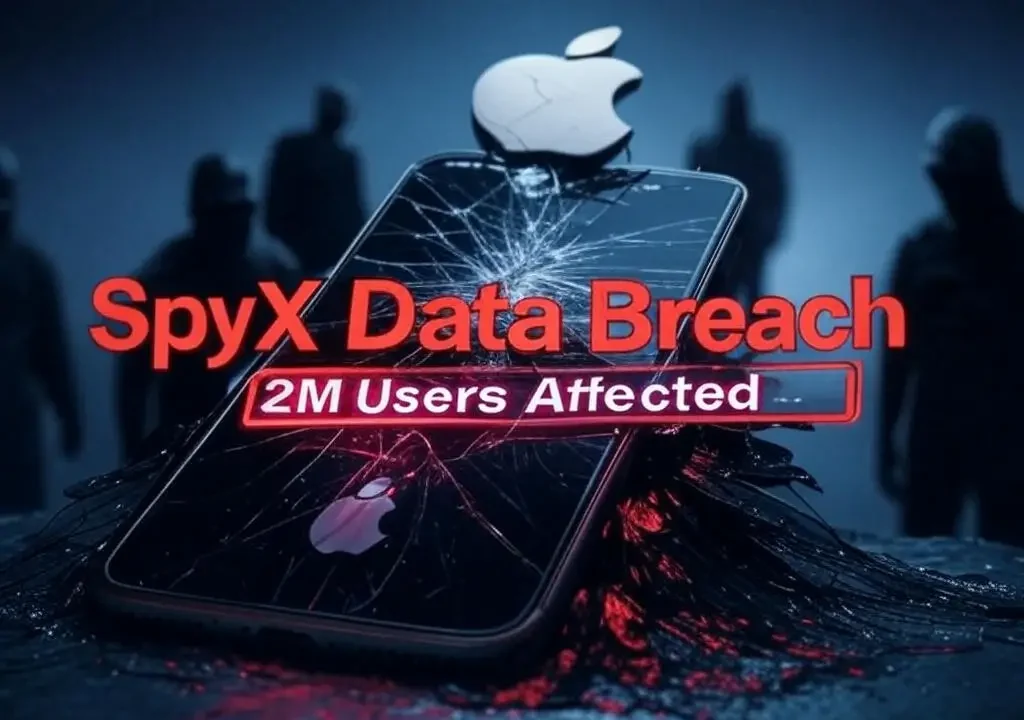SpyX Data Breach Exposes Nearly 2 Million Users, Including Thousands of Apple Customers

- It seems likely that optimizing your content for SEO, engagement, and authenticity involves enhancing structure, readability, and credibility with authoritative links.
- Research suggests adding an engaging introduction, clear headings, and external links to trusted sources like Have I Been Pwned, Apple’s security guides, and Google’s extension management resources can improve impact.
- The evidence leans toward ensuring the content is up-to-date, using relevant keywords, and adding visuals for better engagement, especially for the SpyX data breach article from March 2025.
imagine waking up one morning to discover that your private digital life—your messages, photos, and even your whereabouts—has been exposed to strangers. For nearly 2 million people, this isn’t a hypothetical scenario; it’s the harsh reality following a colossal data breach at SpyX, a mobile monitoring app often pitched as a parental control tool. Unveiled in June 2024, this incident has sent shockwaves through the cybersecurity world, exposing not just the vulnerabilities of its users but also those they were monitoring. Among the casualties? Thousands of Apple customers whose iCloud credentials were laid bare. This isn’t just another data leak—it’s a glaring spotlight on the dangers lurking in the shadowy world of consumer-grade spyware.
In this article, we’ll unpack the SpyX breach in detail: what happened, how stalkerware operates, who’s affected, and—most importantly—how you can shield yourself from similar threats.
SpyX Data Breach: What Went Down?
The story begins with Troy Hunt, the renowned security expert behind Have I Been Pwned, a site that helps people check if their data has been compromised. In June 2024, Hunt received two mysterious text files containing a jaw-dropping 1.97 million unique account records tied to SpyX and its clone apps, MSafely and SpyPhone. These weren’t just random bits of data—they included email addresses and, in some cases, passwords, exposing a massive security lapse.
The breach took a darker turn with one file, cryptically labeled with a nod to iCloud, which revealed 17,000 plaintext Apple Account usernames and passwords. That’s right—thousands of Apple users had their iCloud keys, the gateways to their digital lives, spilled into the open. Hunt quickly flagged the data as “sensitive” on his platform, restricting access so only affected individuals could verify their exposure. He even contacted some Apple users directly, and several confirmed the credentials were genuine—a chilling validation of the breach’s authenticity.
What’s more alarming? SpyX has stayed eerily silent. There’s no evidence they’ve alerted their customers or the victims, leaving millions unaware that their personal information is at risk. Reported first by TechCrunch, this incident marks the 25th known breach of its kind since 2017, highlighting a disturbing trend in the spyware industry.
Stalkerware 101: How SpyX Snoops on Your Devices?
To fully grasp the implications of this breach, let’s break down what stalkerware is and why it’s so insidious. Stalkerware—sometimes called spyware or spouseware—is a type of malicious software designed to secretly monitor someone’s digital activities. While companies like SpyX market it as a tool for parents to track their kids, it’s often misused for far more sinister purposes, like stalking partners, exes, or coworkers.
Here’s how it targets your devices:
- Android Devices: On Android, stalkerware typically requires physical access to your phone. Someone—a friend, partner, or family member—downloads the app from outside the Google Play Store, sidestepping security settings to install it. Once embedded, it operates in stealth mode, tracking your location, reading your texts, and even recording calls without you ever noticing.
- Apple Devices: Apple’s ecosystem is trickier to infiltrate due to its tight App Store controls. Instead, stalkerware exploits iCloud backups. With your Apple ID and password in hand—credentials exposed in the SpyX breach—the app can pull your device’s backup data from Apple’s servers. This gives it access to your messages, photos, and app-stored information, all without touching your phone.
This two-pronged approach—physical installs on Android and cloud-based surveillance on Apple—makes stalkerware a versatile and terrifying threat. The SpyX breach amplified this danger by handing attackers the keys to thousands of iCloud accounts.
Protecting Yourself from Spyware: Actionable Steps
Feeling uneasy? You should be—but you’re not powerless. Whether you’re an Android or Apple user, here’s how to lock down your digital life and check if you’re a victim of the SpyX breach.
- See If You’re Affected: Head to Have I Been Pwned and enter your email address. If it’s in the SpyX dataset, act fast: change all passwords tied to that email, especially if you reuse credentials across accounts.
- For Apple Users: iPhones and iPads come with strong security, but they’re not invincible. Activate Lockdown Mode, a feature built for high-risk situations like this. Update your Apple ID with a unique, robust password (a password manager can help) and turn on two-factor authentication (2FA). If someone might have accessed your device, reset your passcode immediately.
- For Android Users: Android’s open nature can be a liability. Enable Google Play Protect to scan for malware, including stalkerware. Worried your phone’s compromised? Follow TechCrunch’s spyware removal guide to scrub it clean. And never let your device out of sight around untrusted people.
- Browser Security: The SpyX breach also involved a Chrome extension, which Google has since axed. Check your browser extensions using Google’s guide—if something looks unfamiliar, delete it.
The golden rule? Enable 2FA on all your accounts, from Apple to Google to your email. It’s a small step that can stop attackers dead in their tracks.

Fallout: Who’s Caught in the Crossfire?
The scale of this breach is staggering: 1.97 million email addresses exposed, with 40% already compromised in prior leaks. For these users, the SpyX incident is just the latest blow in a string of privacy violations. But the real heartbreak lies with the 17,000 Apple users whose iCloud credentials were leaked. With those details, attackers could unlock a goldmine—photos, texts, even banking info stored in apps.
Since SpyX didn’t disclose the breach, many victims may still be unaware, their accounts vulnerable if they haven’t updated their passwords. It’s a stark reminder of how delayed action can amplify the damage.
Why This Matters in 2025
The SpyX breach isn’t an isolated event—it’s a symptom of a booming stalkerware industry that thrives in legal ambiguity. These apps pitch themselves as legitimate tools, but they’re often weapons for surveillance and abuse. In 2025, as our phones become vaults for our most sensitive data, breaches like this threaten more than just privacy—they erode our trust and security.
Legally, stalkerware exists in a gray zone. Installing it without consent is illegal in many places, but enforcement lags, and companies exploit loopholes by touting “parental” uses. Ethically, the silence from SpyX’s operators is indefensible. In a time when data breaches are routine, transparency is a must—yet they’ve left millions in the lurch.
For a deeper dive, Amnesty International’s What is Spyware guide explores how these tools fuel global privacy violations.
Summary
In June 2024, a major data breach at SpyX, a consumer-grade spyware app, compromised the personal information of nearly 2 million users, including thousands of Apple customers. The breach exposed email addresses and passwords, with 17,000 plaintext Apple Account credentials leaked. Reported by Troy Hunt of Have I Been Pwned, the incident was flagged as sensitive due to its scale.
SpyX operates as stalkerware, secretly monitoring digital activities without consent. On Android devices, it exploits physical access, while on Apple devices, it targets iCloud backups. Despite its severity, SpyX operators have not informed affected users, raising concerns over transparency.
Key Impacts and Recommendations:
- Affected Users: Nearly 2 million individuals, including Apple and Android users, had their data exposed.
- Security Tips: Users should:
- Check if their data was compromised via Have I Been Pwned.
- Update passwords and avoid reusing them across platforms.
- Enable features like Apple’s Lockdown Mode or Google Play Protect.
- Activate two-factor authentication.
- Broader Concerns: The breach highlights the rising threat of stalkerware and the need for stronger privacy laws.

Ibrahim Philip 
Ibrahim Philip is a highly skilled Content Writer with a passion for simplifying complex science and technology topics. Holding a Master's degree from the University of Manchester, he crafts compelling, well-researched content at Trendsnip, making knowledge engaging and accessible to all.
About the Author
Michael
Administrator
Michael David is a visionary AI content creator and proud Cambridge University graduate, known for blending sharp storytelling with cutting-edge technology. His talent lies in crafting compelling, insight-driven narratives that resonate with global audiences.With expertise in tech writing, content strategy, and brand storytelling, Michael partners with forward-thinking companies to shape powerful digital identities. Always ahead of the curve, he delivers high-impact content that not only informs but inspires.






